Content
- 1 Lawn seed selection rules
- 2 Types of grasses and lawn mixtures
- 3 The best varieties of lawn grasses for the Russian climate
- 4 The most adapted herbs to the Russian climate
- 5 Additional components in mixtures
- 6 Herbs with specific properties
- 7 5. Green Meadow
- 8 4. Lilliputian
- 9 3. Green square
- 10 2. Powerseed
- 11 1. Terragrün
There is a lot of trouble with your lawn: does the grass look not as decorative as on the package with seeds, does it freeze in places, turn yellow, thin out and overgrow with weeds? Perhaps you have chosen the wrong varieties for our climatic conditions. Which lawn grass is best for you, and which varieties are better to choose, we will tell you today.
Lawn seed selection rules
The grass on the lawn should be perennial, frost-resistant, and fast growing. These are important conditions for an ideal lawn, but not the most important ones. We list the main factors of buying seeds for sowing on the lawn, which are better to choose in the store:
- Adaptation to specific climate conditions;
- Good development of the root system;
- Saturation of greenery and uniformity of seedlings;
- Ability for vegetative reproduction;
- Good cut tolerance.
Do not neglect the general rules for choosing lawn grass: the shelf life of the material, pre-treatment of seeds, manufacturer's guarantees, etc.
Small video footage about lawn grass
Types of grasses and lawn mixtures
For the lawn, it is best to use cereals. They have a good root system, produce uniform green shoots, help remove weeds and have an excellent decorative appearance after cutting. Most often, such grasses are sown as meadow bluegrass, bent grass, ryegrass, fescue and others. Various grass mixtures are also popular.

Ryegrass belongs to the elite herb varieties. It looks very beautiful in any place free from landings. This variety is sensitive to watering and loves mineral fertilizing.
Interesting to read: Self-planting lawn grass on the site
Herbal mixtures
- Versatile blend... The herbs in this mixture are fast germinating, resistant to external conditions, remove weeds and are inexpensive. The only negative is that such a lawn requires frequent mowing.
- Sports varieties... It is a type of cereal mixture for playgrounds, stadiums and outdoor activities.
- Climate-specific mixtures... It is important to choose varieties of grass for the lawn not only in appearance, but also in climatic characteristics. There are special mixtures for areas that are under the scorching sun. If you want to sow shady places, you should pay attention to shade-tolerant grasses.
- Mixes of flowers and herbs... Such compositions are sown to create a meadow-type lawn. You can choose ready-made herb mixes or mix flowers and cereals that can bloom all summer in succession. Low-growing greenery is suitable for a neat, bright meadow lawn, and you can decorate a country-style plot with tall grasses and flowers.
- Elite lawn composition... Although a mixture of elite herbs is capricious and sensitive to external conditions, its appearance justifies all means. Such grasses look very decorative and can decorate any places free from planting.
The best varieties of lawn grasses for the Russian climate
1. Meadow bluegrass. This perennial variety is one of the earliest cereals. In its pure form, it is practically not sown, since the roots of this herb slowly take root. Bluegrass is an excellent base for a grass mixture. It produces soft and juicy greens, displaces weeds and grows well with other grains.
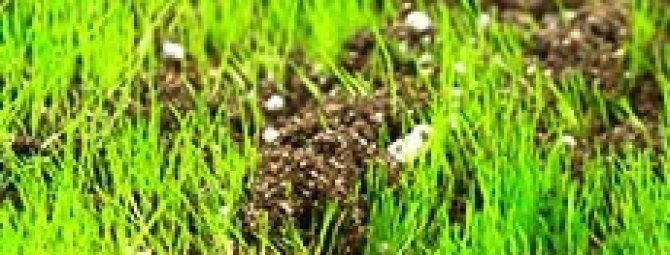
It happens that with proper care, the lawn still does not please with its density, in some places it freezes over the winter and requires frequent overseeding.These are all consequences of an incorrectly selected herbal mixture. When buying, we usually pay attention only to the information for which type of lawn the mixture is intended (sports, parterre, etc.). The herbs that make up the composition are of less interest to us, especially since their names will say little to an ordinary buyer. But this information is more important than the rest, because a lot of mixtures are imported into our country from Europe. The climate there is milder, and the criteria for the selection of lawn grasses are not so strict. But in our harsh climate, the European lawn often freezes out, because it does not contain frost-resistant grasses. To avoid such problems, lawn grass must be selected for its climate and soil adaptability. Let's take a closer look at this.
- What are the requirements for a quality herb?
- The most adapted herbs to the Russian climate
- Additional components in mixtures
- Herbs with specific properties
- Herbs unsuitable for the Russian climate
- Latin clues
What are the requirements for a quality herb?
Any ornamental grass for a lawn must be a perennial, because the lawn is created for more than one year, and it makes no sense to sow the site in a new way every spring. Of all existing plant species, cereals are the most adapted to the conditions of the lawn. But not all, but only those that meet the following requirements:
- Freeze resistant.
- Externally decorative (juicy green flowers, with uniform germination of shoots, with the same cover density, etc.).
- They develop a strong root system that does not collapse as a result of movement, is able to grow on compacted soils, etc.
- After mowing, they quickly build up the cover and respond well to mineral fertilizers.
- The ability to reproduce vegetatively, because seeds on the lawn cannot multiply with the help of seeds.
The most adapted herbs to the Russian climate
If we analyze all the plants offered in mixtures according to the five listed criteria, then from the whole variety there will be only three names of grass for the lawn, ideally meeting the conditions of Russian weather. These are bent grass, red fescue and meadow bluegrass. All of them are included in the group of short-rhizome cereals and have similar properties.
These plants are not afraid of temperature contrasts, especially with frosts in early spring or late autumn. Their root system withstands severe frosts and forms such a dense sod that it is simply unrealistic for weeds to break through it. For 1 sq.m. about 30 thousand shoots develop. Grasses withstand frequent mowing, have a high rate of vegetative propagation, therefore, with proper care, the lawn will serve without overseeding for decades.
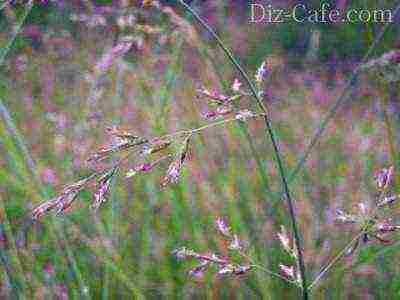
Red fescue grows rather slowly, so in the first year of planting the lawn will look sparse, but the next season the plant creates a dense, even cover.
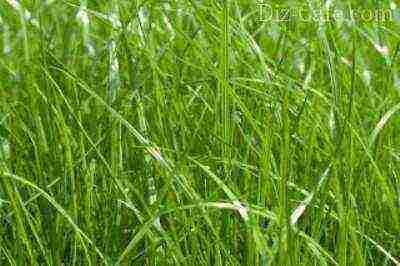
Meadow bluegrass is not worth buying in its pure form, because it slowly builds up the root system. It is better to take a mixture where it is the main component.

The slender bent is famous not only for its winter hardiness and unpretentiousness, but also for its rich dense green color, which gives the lawn a rich look
When studying the compositions of mixtures in stores, choose for yourself those that contain the largest percentage of these particular cereals. Sometimes the names of the components are written in Latin on the packaging. Memorize how these three herbs sound in Latin:
- The bent bane is designated Agrostis tenuis;
- Meadow bluegrass is Poa pratensis;
- Red fescue translates as Festuca rubra.
Additional components in mixtures
In addition to three cereals, other plants can be found in mixtures that are suitable for the climate of our latitudes. All of them will have good frost resistance and ease of maintenance. But there are some disadvantages that do not allow us to consider these grasses the best for the lawn.And if you find their names in the mixture, then remember that they should not be the main component, but can be used as a supplement.
Here are the types of herbs commonly used in lawn mixes:
- Pole grass escaping. The best quality is very fast growth. Minus - gives horizontal shoots, which are distinguished by a light color against the background of a dark green lawn. This gives the lawn an uneven color. This quality is inappropriate on parterre lawns, although it is not so important for a recreation area.
- Other types of bluegrass. In addition to meadow, which we described earlier, there are narrow-leaved, common and flattened bluegrass species in mixtures. They are characterized by poor durability, i.e. after 5-7 years, they require reseeding, and the decorative properties are lower (the blades of grass are too hard and with a gray tint).

The light green color of the horizontal shoots of the common bent grass contrasts with the color of the main lawn grass, so the grass is not suitable for parterre lawns
Herbs with specific properties
There are some types of low-growing lawn grasses that are adapted to specific growing conditions. They cannot be called universal, but it is recommended to plant them for certain parts of the site.
So, oak grass bluegrass has a high ability to grow in partial shade. Those. under garden trees and in places near buildings where light rarely enters, this plant will relieve the lawn of bald patches and pale cover. True, you should take into account that the bluegrass cannot form a dense root system, therefore it cannot stand movement and frequent mowing.
Swamp bluegrass will save the situation on lawns with high humidity, where there is no drainage. It forms a beautiful green canopy and develops strong roots, but does not live long and requires frequent sowing. It can be combined with white bent grass, which also grows well in moist soil. But its decorative properties are lower than that of bluegrass, and the lifespan is about 8 years.
For parterre lawns, on which it is not planned to walk at all, you can use the bent bent. It is one of the most luxurious herbs in appearance, because it has an emerald color and delicate, thin blades of grass. Such a lawn is also called "velvet", because from a distance it looks like an expensive fabric. But with all the external advantages, the plant is very capricious. It lives for about 5 years, has weak roots, grows slowly and is absolutely not resistant to trampling.
If it is important for you that the lawn looks aesthetically pleasing in a month or two, then pick up a mixture that contains meadow fescue. This is the fastest growing cereal that will close its stems after 2 months. It can be used in its pure form for a temporary lawn, which is destined to grow in one place for 4 years, because the grain does not live longer. In addition, meadow fescue has weak roots that are afraid of trampling. But in the composition of the mixture, this cereal can be very useful as an addition to the main herb. For example, meadow bluegrass grows slowly, and while it is in full force, empty spaces will successfully cover the stems of meadow fescue.
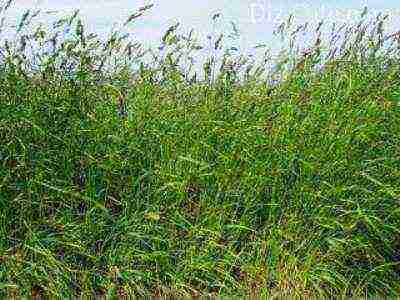
Meadow fescue will save the owners when it is urgent to make the lawn decorative, because after 2 months the blades of grass form a continuous thick carpet
Your lawn will be thick already in the first summer, however, a little bit motley. Meadow fescue has wide stems and a light color, which will look contrasting against the background of narrow dark green blades of bluegrass. The next year, when the main grass begins to grow rapidly, it will simply squeeze out this cereal and take its place.
Herbs unsuitable for the Russian climate
There are herbs in European blends that should be avoided when planting on lawns because they are designed for mild climates.For example, perennial ryegrass has excellent growth, decorative properties and a dense cover, but after the first winter your lawn will noticeably “shed light”, although in Europe such lawns have been successfully turning green for about 8 years.
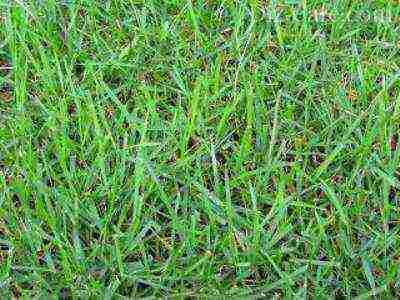
Perennial ryegrass (pasture) is capable of surprising only in the first year after planting. The harsh winter is beyond his powers
Often found, as an additional component of the mixture, annual bluegrass. Its feature is unpretentious care and rapid growth. But this cereal multiplies by seeds, so that with constant mowing for the next year, it will in no way be able to give offspring and will free the land for germination of weeds.
Another “two girlfriends” - turfy pike and sheep's fescue - are good in all properties, except for one: they form bumps over time, and gradually your lawn will turn into a field of green mounds.
Latin clues
To make it easier for you to navigate, reading the compositions of lawn mixtures, and to better understand what grass for the lawn the manufacturer offers, we have collected the names of the herbs described in the article in Latin. Remember them and look for them on the packages:
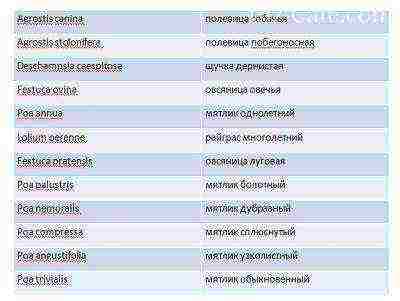
Before creating your lawn, it's worth asking yourself a few questions. First, what, exactly, do you need a lawn for? For beauty? For outdoor sports? Or for everything at once? Secondly, what are the conditions in the area intended for the lawn - sun, shade, wet, dry, acidity of the soil is high or low? And already based on this, make a choice from the list the best lawn grass producers.
As a rule, only some varieties of herbs are suitable for the Russian climatic zone. Therefore, before buying, you should carefully read the composition of the mixture and determine if there are the following species: meadow bluegrass, red fescue and perennial ryegrass. Sometimes bent grass (its different species) is added to them. Despite some scarcity of the basic set, each species has many varieties that differ in appearance, growth rate, resistance to lesions, and so on.
There are several requirements for high-quality lawn mixtures:
- they should quickly take root (even on soil that is not rich in nutrients);
- after mowing, grow more slowly, but at the same time the brightness of the color and density should remain the same;
- it is good to tolerate temperature extremes typical for Russia;
- be resistant to diseases and pests.
If the lawn in your country house has already grown, you should think about buying a lawn mower, we have selected the best models for you:
- Top 10 Electric Lawn Mowers of 2017
- 10 best gasoline lawn mowers ranked 2017
In Russia, the most popular are five producers of herbal mixtures.
5. Green Meadow
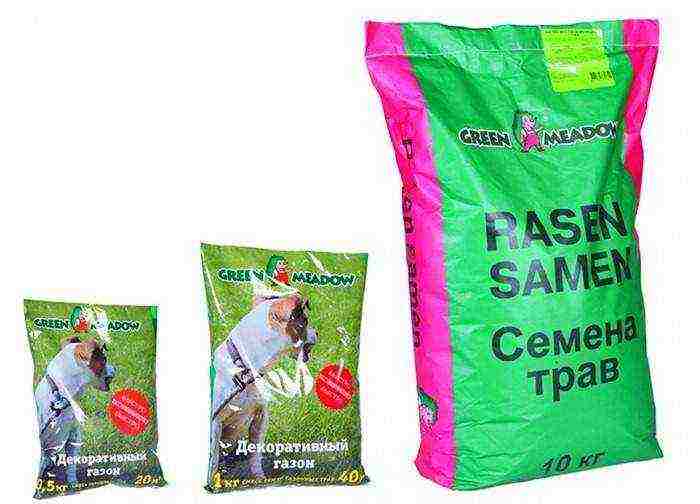 The rating of manufacturers of high-quality grass mixtures for lawns is opened by the American company Green Meadow. It is one of the most renowned suppliers of a variety of plants in both the United States and Europe. She has a rich assortment, however, a Russian lawn lover should remember that a rare mixture will take root on Russian soil. The basis of the mixture is perennial ryegrass, it is very beautiful in appearance, but short-lived. Ryegrass is a part of many mixtures, as its fast germination will provide the lawn with a beautiful, even color at the very beginning, and then give way to more long-lived grasses. At the same time, he still does not tolerate frosts and dies at temperatures from -15 and below. Residents of the southern regions of Russia can enjoy its bright malachite color, but "Europeans" and Siberians should think hard.
The rating of manufacturers of high-quality grass mixtures for lawns is opened by the American company Green Meadow. It is one of the most renowned suppliers of a variety of plants in both the United States and Europe. She has a rich assortment, however, a Russian lawn lover should remember that a rare mixture will take root on Russian soil. The basis of the mixture is perennial ryegrass, it is very beautiful in appearance, but short-lived. Ryegrass is a part of many mixtures, as its fast germination will provide the lawn with a beautiful, even color at the very beginning, and then give way to more long-lived grasses. At the same time, he still does not tolerate frosts and dies at temperatures from -15 and below. Residents of the southern regions of Russia can enjoy its bright malachite color, but "Europeans" and Siberians should think hard.
4. Lilliputian
 Liliput lawn mixture is specially designed for the harsh Russian climate and made as undemanding as possible. This is a lawn for the lazy (or for those who cannot garden more than one day in a couple of weeks). The herb mixture from "Liliput" is based on meadow bluegrass and four parts of different varieties of fescue.All varieties are very hardy and resistant to negative environmental factors - from temperature changes to diseases.
Liliput lawn mixture is specially designed for the harsh Russian climate and made as undemanding as possible. This is a lawn for the lazy (or for those who cannot garden more than one day in a couple of weeks). The herb mixture from "Liliput" is based on meadow bluegrass and four parts of different varieties of fescue.All varieties are very hardy and resistant to negative environmental factors - from temperature changes to diseases.
3. Green square
 Another domestic manufacturer opens the top 3 of the best lawn grass mixtures. It differs from "Lilliput" both in a large number of options and in a more favorable price. Although the difference in price starts to be felt at large scales, for example, if the area of the lawn starts from 50 m2 or more. There are mixtures specially designed for various climatic regions of Russia - from the subtropical zone of the Caucasus to the arid Lower Volga region and harsh Siberia.
Another domestic manufacturer opens the top 3 of the best lawn grass mixtures. It differs from "Lilliput" both in a large number of options and in a more favorable price. Although the difference in price starts to be felt at large scales, for example, if the area of the lawn starts from 50 m2 or more. There are mixtures specially designed for various climatic regions of Russia - from the subtropical zone of the Caucasus to the arid Lower Volga region and harsh Siberia.
2. Powerseed
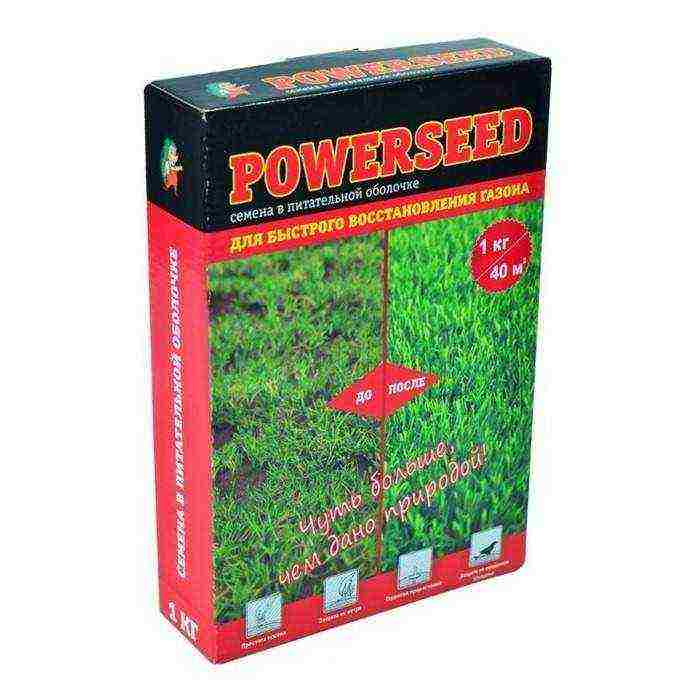 Powerseed lawn mixes are adapted to the western / central climatic conditions of the USA, therefore, are suitable for the central and southern regions of Russia. One of the most popular mixes is for quick restoration of lawns. It is convenient that the old lawn does not need to be dug up, fertilized, or regularly watered. It just grows by itself - what else is needed?
Powerseed lawn mixes are adapted to the western / central climatic conditions of the USA, therefore, are suitable for the central and southern regions of Russia. One of the most popular mixes is for quick restoration of lawns. It is convenient that the old lawn does not need to be dug up, fertilized, or regularly watered. It just grows by itself - what else is needed?
1. Terragrün
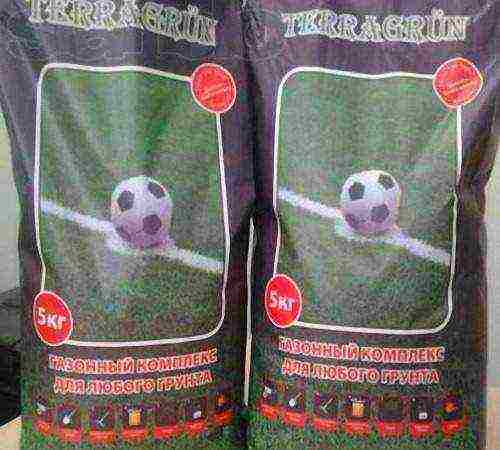 One of the hallmarks of Terragrün is its own mixtures, in which wild species and cultivated varieties are mixed in various proportions. At the same time, the germination rate of seeds from German craftsmen reaches 95% (one of the highest rates on the market). A wide range of products will help create a lawn not only in the favorable climatic conditions of the south of Russia, but also in other, colder regions.
One of the hallmarks of Terragrün is its own mixtures, in which wild species and cultivated varieties are mixed in various proportions. At the same time, the germination rate of seeds from German craftsmen reaches 95% (one of the highest rates on the market). A wide range of products will help create a lawn not only in the favorable climatic conditions of the south of Russia, but also in other, colder regions.
The varieties "Universal", "Canada-green", "Golf-Master" are very popular in the market. By the way, the latter, despite its specialized name, is actually very stable and looks great in the lawn. The only drawback is that it requires a good drainage system, since it does not tolerate soil freezing and may die.

